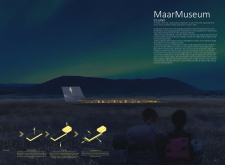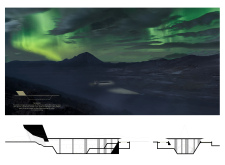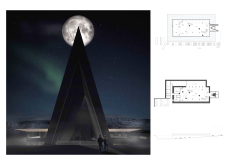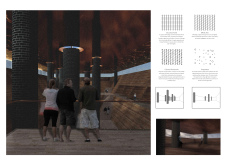5 key facts about this project
The Maar Museum, located in Iceland, serves as a unique space for showcasing the region’s volcanic heritage. Its design connects closely with the surrounding landscape, aiming to reflect the area’s geological features while offering visitors views of the stunning environment. The overall concept emphasizes a relationship between nature and architecture, creating an engaging experience for all who enter.
Entrance Design
The entrance is a key element of the design, capturing the theme of an 'eruption.' Visitors approach a cave-like entry that guides them downward, inviting them into the building. This movement from a narrow, intimate space to a larger, brighter main hall mirrors the experience of traversing through a naturally formed geological structure.
Structural Framework
The floating roof is supported by a conventional grid system, which helps to maximize natural light through the clear storey. This design choice reduces the building’s impact on the landscape, allowing it to blend with its surroundings. Columns are strategically placed to frame views of the outdoors, enhancing the relationship between the interior and the natural environment. The varying diameters of the columns not only provide strength for larger spans but also create 'light wells' that bring daylight deeper into the interior.
Material Use
Materials play an important role in shaping the experience within the museum. Polished copper is used on the ceiling, offering reflective qualities that change with different lighting throughout the day. Rammed concrete references the volcanic context of the site, establishing a historical link. Locally made corbelled bricks are used in the interior, adding a textured feel that evokes the natural caves found in the surroundings.
Water Feature
A pool of water surrounds the museum, acting as an important component of the design. This reflective feature enhances the interior atmosphere, filling the space with soft light and creating an ongoing connection between the building and the landscape. The movement of water echoes the geological processes that define the region, further enriching the museum's narrative.
As visitors explore the various spaces, they experience a rich interplay of light and shadow, informed by the museum's thoughtful design and natural elements. The experience reflects the powerful geological history of Iceland, inviting a deeper appreciation of the environment.






















































